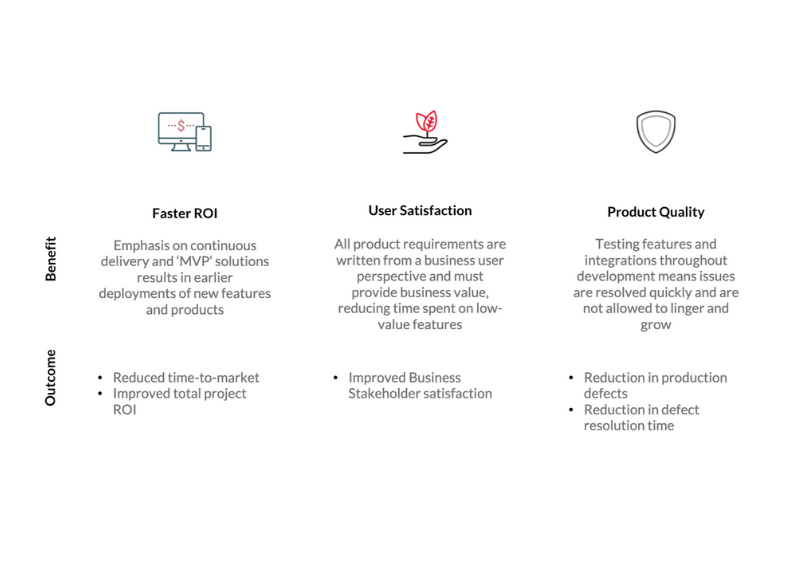Strategy
Mar 16, 2020
Make Agile Stick: Planning for the People Factors of an Agile Transformation

What happens when an Agile transformation fails?Most likely, the business won’t have to totally start over. However, a failed transformation does lead to confusion and frustration for your teams. Teams will be using different processes, project plans will be inconsistently formed, and everyone will be using different terminology to talk about the same things. If your Agile transformation fails—that is, if your people do not move to a new way of doing business—then you may be left with a mess. But there is a way to plan from the beginning to avoid some of the pitfalls that can lead to failure.
Any type of transformational change requires a thorough, people-first approach in order to realize a return. So, what does that mean? Moving to Agile requires more than a single process change or directive—it involves redesigning processes, toolsets, dictionaries, and day-to-day activities. Your vision for the future Agile state will be customized for your business, so it must be thorough. Furthermore, the goal of your plan is to change individual behaviors. Doing so necessitates a detailed understanding of their day-to-day functions, motivations, and hesitations. In short, changing behavior is a people-centric activity.
Although there is no one-size-fits-all approach for moving to an Agile model successfully, there is a reliable framework you can tailor to your specific needs. The key factors to keep in mind are a focus on being thorough and people-first.
Using a People-First Approach to Drive Agile Adoption
1. Align Sponsors Behind a Case for Change
The first people who need to be involved in driving an Agile transformation are the executive sponsors accountable for its success. Getting busy executives engaged and aligned requires a clear reason for the transformation. You must ask and answer the question, “Why do we want to adopt Agile?” The answer to this question becomes your case for change—the rationale for adopting Agile that will inform the rest of your efforts.
The case for change may include reducing time to market, increasing project predictability, increasing client satisfaction, or reducing defect resolution time. Whatever your reason for switching to Agile is, be sure to define this and communicate it from the beginning. Engaging executive sponsors early on allows you to identify project champions. Once the case for change is defined and a compelling value add communicated, those impacted by the change (including those who aren’t on board from the beginning) will be more willing to adopt Agile. A sample case for change is illustrated below.
SAMPLE CASE FOR CHANGE

2. Conduct Stakeholder Analysis
Once the case for change is defined and executive sponsors are identified, it’s time to conduct a stakeholder analysis. According to McKinsey, change programs are 30% more likely to stick when relevant stakeholders are invested. Therefore, it’s critical to assess early on who will be impacted and how the change will affect them. Although the clear stakeholders are those who will be directly affected by the change (software engineers, testers, and product managers), a wider view of your organization will identify others who will need to adapt to Agile practices. Taking an enterprise-wide view of stakeholders helps proactively identify any potential surprises that could derail a major transformation part-way through.
After relevant stakeholders have been defined, conduct assessments to gauge the impact on their teams and their likely reactions to the change. Also identify specific employees who could be ‘blockers’ or ‘champions’ for the transformation. It is critical to bring both groups into the fold—blockers will highlight areas that need to be addressed, while champions will communicate critical benefits and other key messages. Taking the time to understand exactly what behaviors will support the transformation and how each group of stakeholders will perceive them is the foundation of a transformation strategy that maximizes adoption and minimizes resistance. From here, you will need to develop a specific plan to help each stakeholder group perform at their best in an Agile framework.
3. Establish Impact/Drive Adoption
You have now communicated your case for change, identified relevant stakeholders, and discovered the behaviors that need to take place for your organization to have a successful Agile implementation. The question becomes, how do we get from assessment and alignment to implementation?
The simple fact is that each transformation plan is different because each one must account for specific cultural and operational factors unique to a single company. Your plan will incorporate communications, trainings, documentation, incentives, and consequences that all aim to move the needle on successful adoption by preparing each individual for the new ways of working. What exactly those trainings cover, which processes must be documented, and how target behaviors are incentivized all depend on your organization as it stands today and the vision for where you want to go.
Moving to the Future
Transitioning to Agile is a big task because it involves convincing an entire organization, sometimes hundreds of people, to change their behavior. Some people will be excited, and some will be hesitant. The key is to understand their motivations and ensure your plan makes the journey from the present to the future as clear as possible. It is a big task, but we are here to help. Credera’s combination of operational experience, broad technology skills, and people-first design principles can be your secret weapon.
Is your company looking to adopt an Agile methodology? Fill out the form below and a member of our team will get in contact with you.
Contact Us
Ready to achieve your vision? We're here to help.
We'd love to start a conversation. Fill out the form and we'll connect you with the right person.
Searching for a new career?
View job openings